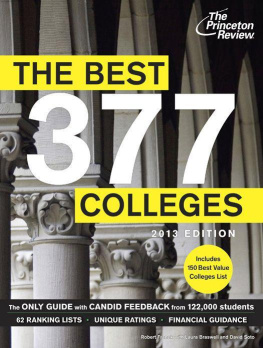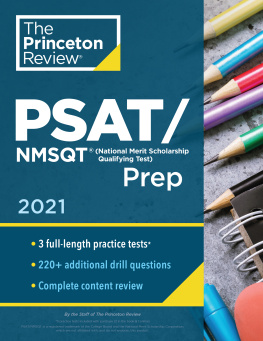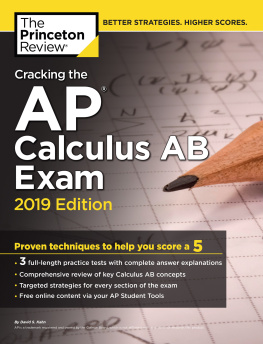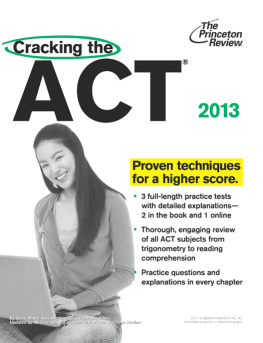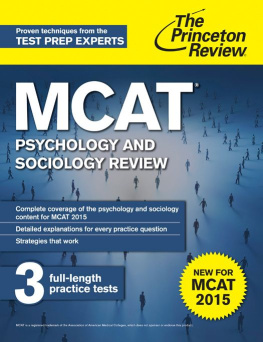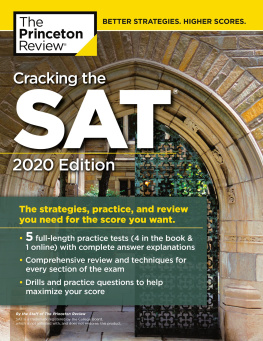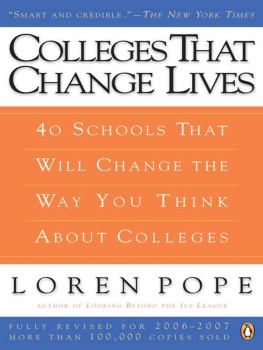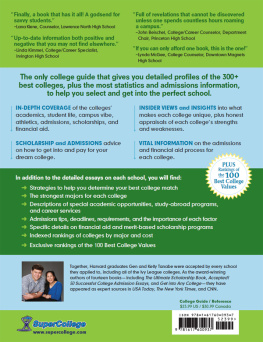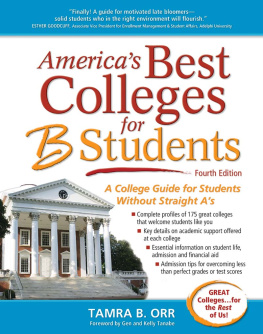2013 Random House eBook Edition
Copyright 2012 by The Princeton Review, Inc.
All rights reserved.
Published in the United States by Random House, Inc., New York and in Canada by Random House of Canada Limited, Toronto.
All rankings, ratings, and listings are the intellectual property of The Princeton Review, Inc. No rankings, ratings, listings, or other proprietary information in this book may be repurposed, abridged, excerpted, combined with other data, or altered for reproduction in any way without the express permission of TPR.
T HE P RINCETON R EVIEW is not affiliated with Princeton University.
Simultaneously published in paperback and in different form by Random House, Inc.
This enhanced eBook contains additional text, photos, and videos.
eBook ISBN: 978-0-307-94601-0
Cover design by Andrea Lau
Cover photograph by Ryan McGinnis/Alamy
Infographics processed by Henry Colomb and Mark Stroud of Moon Street Cartography
Videos by Hannah Jayanti and Ranjan Das
Cover art in Improving Your Score Video INSADCO Photography / Alamy
for this eBook are listed after the index.
Princeton Review
Senior VPPublisher: Robert Franek
Print Edition Editor: Laura Braswell
Content Director: David Soto
Student Survey Manager: Stephen Koch
The Princeton Review
111 Speen Street, Suite 550
Framingham, MA 01701
E-mail:
Random House
Publisher: Tom Russell
Publishing Director: Nicole Benhabib
Producer: Jaki Clark
eBook Production Lead: Lillian Sullam
Visual Team Lead: Jennifer Romains
Managing Editor: Alison Stoltzfus
www.randomhouse.com
www.princetonreview.com
2013 Edition
eBook version v3.1
Contents
A Note to the Reader
This eBook is best viewed in portrait mode. Please adjust your font settings to the publisher defaults if available on your device. Otherwise some content may be displayed with incorrect or hard-to-read formatting.
INTRODUCTION
There is video content at this location that is not currently supported for your eReading device. The caption for this content is displayed below.
An introduction to The Best 377 Colleges from Rob Franek, SVP & Publisher of The Princeton Review.
TOOLS TO GET STARTED
Preparing in High School
There is video content at this location that is not currently supported for your eReading device. The caption for this content is displayed below.
Quick tips on getting into your top-choice schools from The Princeton Review.
Quick Tips
- In your sophomore and junior years, establish relationships with teachers and advisors who can write strong letters of recommendation for you.
- Its good to include extracurriculars (like student government, newspapers, community service, or sports) on your application, but colleges would rather see you focus on a few worthwhile activities rather than divide your time among a bunch of activities youre not passionate about.
- Its critical that your junior-year grades are solid. Colleges put a heavy emphasis on junior-year grades when they review transcripts, since your application will probably be reviewed before you have all your senior-year grades.
- If youre not happy with your previous SAT scores, you can still take the SAT in October of your senior year to make college admission deadlines.
For more tips on what to do each year in high school, read
Financial Aid Tips
There is video content at this location that is not currently supported for your eReading device. The caption for this content is displayed below.
Tips from The Princeton Review on the financial aid process.
Quick Tips
- Dont rule out any school as too expensive. A generous aid award from a pricey private school can make it more affordable than a public school with a lower sticker price.
- Apply for financial aid no matter what your circumstances. Some merit-based aid can only be awarded if the applicant has submitted financial aid application forms.
- Apply strategically to colleges. Your chances of getting aid will be better at schools that have generous aid budgets (see our schools).
- Complete the FAFSA and any college-specific aid forms as early as possible because some funding is limited and distributed on a first-come, first-served basis.
For more financial aid tips, read .
Improving Your Score
There is video content at this location that is not currently supported for your eReading device. The caption for this content is displayed below.
Tips from The Princeton Review on improving your standardized test scores.
Quick Tips
- The best way to improve your score is to take the test thats best for you. All colleges accept both ACT and SAT scores, so you can take the test that youll do best on. To find out which is right for you, take our free Princeton Review Assessment at one of our offices or at PrincetonReview.com. Also check out our book, ACT OR SAT?: Choosing the Right Exam for You.
- Get cracking on taking practice tests. The more familiar you are with the test, the more confident and savvy a test-taker youll be. Learn what each section covers, its time limit, and its question types. We cover this and more in our courses and test prep books, including Cracking the SAT and Cracking the ACT.
- Get started early. Allow 23 months to prepare for the test, and be sure to take some practice tests in a timed setting as similar to the actual test experience as possible.
- Use all the resources available to you. Whether you are working alone, pairing up with a study partner, or taking a test-prep course, find the type of test prep that best fits your learning style, budget, and needsand have fun preparing!
For more help improving your standardized test scores, visit PrincetonReview.com for additional information on books and test services.
START YOUR SEARCH
Finding Your Best Fit School
There is video content at this location that is not currently supported for your eReading device. The caption for this content is displayed below.
Tips on finding your best fit college from The Princeton Review.
Browse Schools AZ
| Z
A
B
C
D
E
F
G
H
I
J
K
L
M
N
O
P
Q
R
S
T
U
V
W
X
Y
Great Schools for 20 of the Most Popular Undergraduate Majors
Worried about having to declare a major on your college application? Relax. Most colleges wont require you to declare a major until the end of your sophomore year, giving you plenty of time to explore your options. However, problems may arise if you are thinking about majoring in a program that limits its enrollmentmeaning that if you dont declare that major early on, you might not get into that program at a later date.

